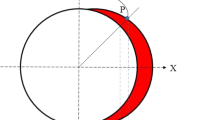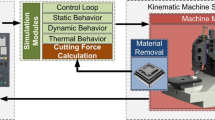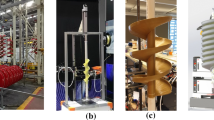Abstract
Industrial robots are increasingly being used as a substitute for multi-axis metal-cutting machines in complex workpiece machining. However, there is a problem with robots’ low rigidity compared to cutting machines. For this reason, robots machining accuracy is still insufficient. Many of the studies explore the estimation of robot links strains to make appropriate corrections of their control software. The finite element method is the most relevant method for strain calculation. However, detailed workpiece CAD models describing all the design features use extremely large number of finite elements. This is a fact that limits application of finite element method by manufacturing engineers. Thus, not only manufacturing engineers but also robot developers find it too difficult to calculate the rigidity using such models. Therefore, there is a problem to modify manufacturing robot control data considering robot strains. In the short and medium terms, this problem can be solved only by using an innovative approach. An application of the robot finite element model, based on its voxel model, is proposed as such an approach. In this case, the voxel model itself is developed using exact robot CAD models developed by manufacturing companies. These voxel and finite element models do not contain specific features of robot design. These models are open-source data and can be distributed from developers to engineers to be used in CAM systems when developing control data for workpiece processing. This approach is illustrated by modeling a four-link industrial manipulating robot. Generated mesh includes 480,000 finite elements and makes it possible to calculate displacements of the robot end effectors during machining process and to consider these displacements in control software developing using CAM system.
Access this chapter
Tax calculation will be finalised at checkout
Purchases are for personal use only
Similar content being viewed by others
References
Pandremenos J, Doukas C, Stavropoulos P, Chryssolouris G (2011) Machining with robots: a critical review. Proceedings of DET2011. 7th international conference on digital enterprise technology. Athens, Greece, pp 1–8
Aliev R, Guseynov R (2011) Milling robots—technical state view. Autom Modern Technol 11:11–18
Moler D-IC, Schmidt HS, Koch P (2017) Machining of large scaled CFRP-parts with mobile CNC-based robotic system in aerospace industry. Procedia Manuf 14:17–194
Kuka KR 3 R540. Technical data. 0000–270–971/V16.3/05.09.2018/en
Sirinterlikci A, Tiryakioglu M, Bird A, Harris A, Kweder K (2009) Repeatability and accuracy of an industrial robot: laboratory experience for a design of experiments course. Technol Interf J 9(2):1–10
Liu S, Liao W, Tian W et al (2017) The problem in accuracy compensation of industrial robot. Int Rob Auto J 3(2):282–283. https://doi.org/10.15406/iratj.2017.03.00050
Nemec B, Žlajpah L (1994) Force control of an industrial robot with adaptive compensation of the environment stiffness. Informatica (Ljubljana) 18(1):81–91
Morozov M et al (2016) Assessing the accuracy of industrial robots through metrology for the enhancement of automated non-destructive testing. IEEE international conference on multisensor fusion and integration for intelligent systems (MFI), Baden-Baden, pp 335–340. https://doi.org/10.1109/MFI.2016.7849510
Slamani M, Nubiola A, Bonev I (2012) Assessment of the positioning performance of an industrial robot. Ind Robot 39(1):57–68. https://doi.org/10.1108/01439911211192501
Semyonov EN, Sidorova AV, Pashkov AE, Belomestnykh AS (2016) Accuracy assessment of KUKA KR210 R2700 extra industrial robot. Int J Eng Technol 16:19–25
Yuan L, Pan Z, Ding D, Sun S, Li W (2018) A review on chatter in robotic machining process regarding both regenerative and mode coupling mechanism. IEEE/ASME Trans Mechatron 23(5):2240–2251. https://doi.org/10.1109/TMECH.2018.2864652
Schneider U, Drust M, Ansaloni M et al (2016) Improving robotic machining accuracy through experimental error investigation and modular compensation. Int J Adv Manuf Technol 85:3–15. https://doi.org/10.1007/s00170-014-6021-2
Kamali K, Joubair A, Bonev IA and Bigras P (2016) Elasto-geometrical calibration of an industrial robot under multidirectional external loads using a laser tracker. IEEE international conference on robotics and automation (ICRA), Stockholm, pp 4320–4327. https://doi.org/10.1109/ICRA.2016.7487630
Józwik J, Ostrowski D, Jarosz P, Mika D (2016) Industrial robot repeatability testing with high speed camera phantom V2511. Adv Sci Technol Res J 10(32):86–96. https://doi.org/10.12913/22998624/65136
Olabi A, Damak M, Bearee R, Gibaru O and Leleu S (2012) Improving the accuracy of industrial robots by offline compensation of joints errors. 2012 IEEE international conference on industrial technology, Athens, pp 492–497. https://doi.org/10.1109/ICIT.2012.6209986
Zhang H, Pan Z (2009) Improving robotic machining accuracy by real-time compensation. ICCAS-SICE international joint conference, IEEE, USA, pp 4289–4294
Östring M, Gunnarsson S, Norrlof M (2003) Closed loop identification of an industrial robot containing flxibilitie. Contr Eng Pract 11(3):291–300. https://doi.org/10.1016/S0967-0661(02)00114-4
Prabhu N, Anand MD, Ruban LE (2014) Structural analysis of Scorbot-ER Vu plus industrial robot manipulator. Prod Manuf Res 2(1):309–325. https://doi.org/10.1080/21693277.2014.907533
Zhang J, Cai J (2013) Error analysis and compensation method of 6-axis industrial robot. Int J Smart Sens Intell Syst 6(4):1383–1399. https://doi.org/10.21307/ijssis-2017-595
Pupăză C, Constantın G, Negrılă Ș (2014) Computer aided engineering of industrial robots. Proc MS 9(2):87–92
Cherchelanov E (2019) 5-axis industrial robot drawing. 3D model. https://www.izhaotuzhi.com/product/view157.html. Accessed 01 May 2019
Author information
Authors and Affiliations
Corresponding author
Editor information
Editors and Affiliations
Rights and permissions
Copyright information
© 2021 The Editor(s) (if applicable) and The Author(s), under exclusive license to Springer Nature Switzerland AG
About this paper
Cite this paper
Shchurova, E.I. (2021). Industrial Manipulating Robot Finite Element Mesh Generation Based on Robot Voxel Model. In: Radionov, A.A., Gasiyarov, V.R. (eds) Proceedings of the 6th International Conference on Industrial Engineering (ICIE 2020). ICIE 2021. Lecture Notes in Mechanical Engineering. Springer, Cham. https://doi.org/10.1007/978-3-030-54817-9_27
Download citation
DOI: https://doi.org/10.1007/978-3-030-54817-9_27
Published:
Publisher Name: Springer, Cham
Print ISBN: 978-3-030-54816-2
Online ISBN: 978-3-030-54817-9
eBook Packages: EngineeringEngineering (R0)




